Finance in Hospitality: Funding, Cost Analysis, and Financial Ratios
VerifiedAdded on 2020/01/15
|25
|8229
|174
Report
AI Summary
This report delves into the financial landscape of the hospitality industry, encompassing various aspects of financial management. It begins by exploring diverse sources of funding, both internal and external, available to businesses within the sector, alongside an evaluation of different methods for generating income. The report then examines key elements of cost, including material, labor, and overhead, and their impact on gross profit percentages and selling prices. Furthermore, it covers methods for controlling stock and cash flow, essential for maintaining financial stability. The report also analyzes trial balances, evaluates business accounts, and makes adjustments. Ratio analysis is performed to assess the financial health and performance of a hypothetical company, with recommendations provided. Finally, the report discusses cost volume profit analysis, including fixed, variable, and semi-variable costs, and concludes with short-term management decisions based on break-even calculations. The report provides an in-depth view of financial decision-making in the hospitality sector.
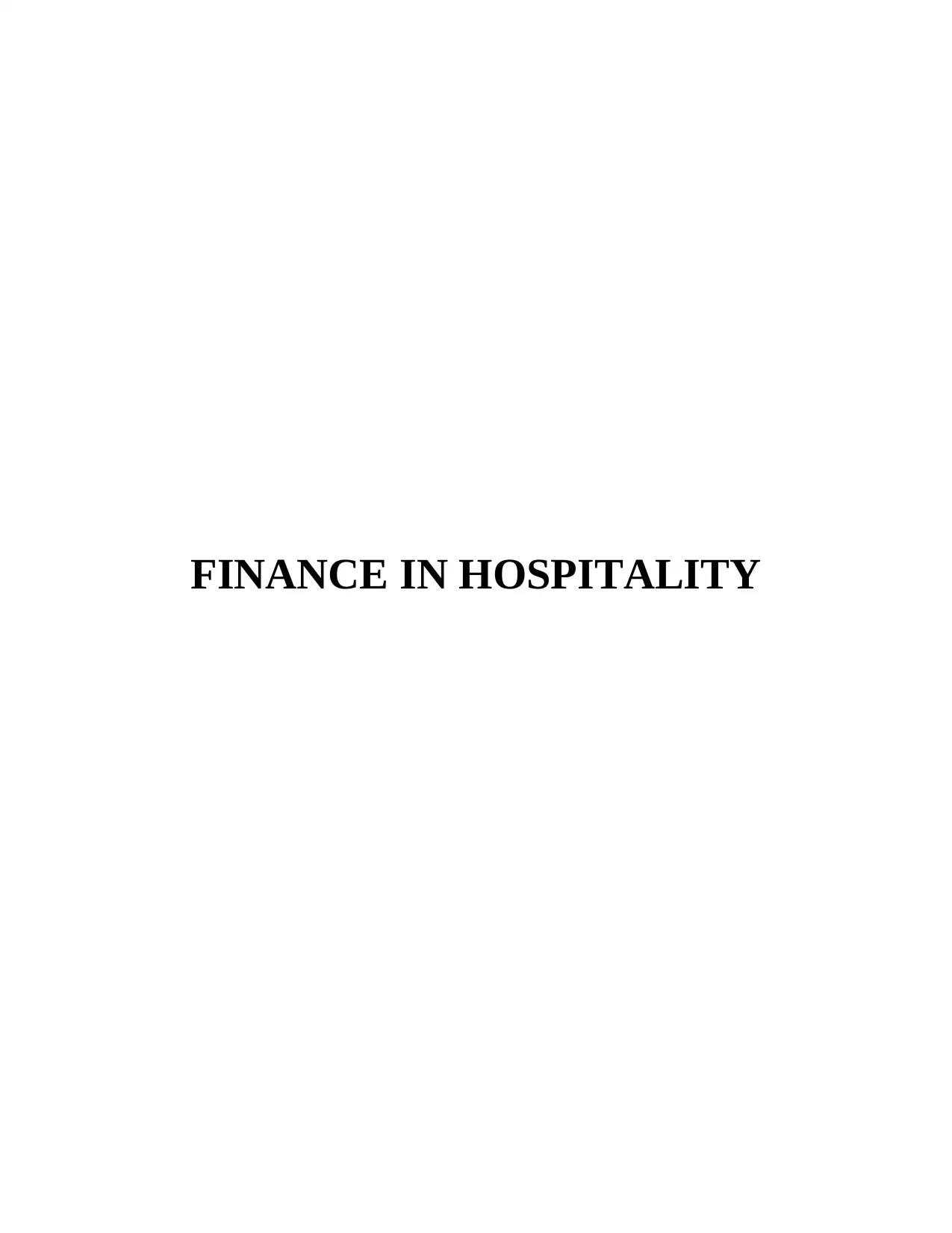
FINANCE IN HOSPITALITY
Paraphrase This Document
Need a fresh take? Get an instant paraphrase of this document with our AI Paraphraser
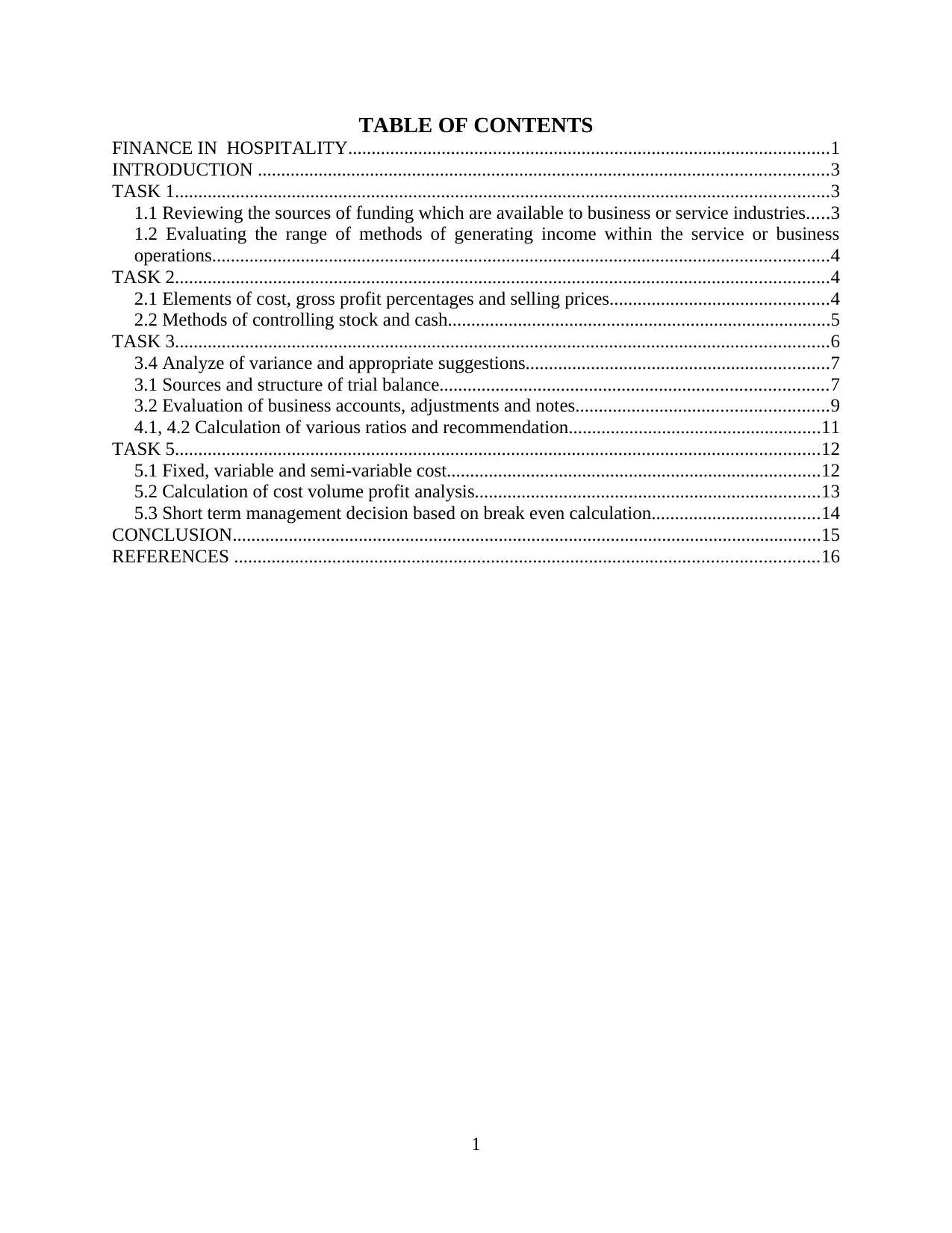
TABLE OF CONTENTS
FINANCE IN HOSPITALITY.......................................................................................................1
INTRODUCTION ..........................................................................................................................3
TASK 1............................................................................................................................................3
1.1 Reviewing the sources of funding which are available to business or service industries.....3
1.2 Evaluating the range of methods of generating income within the service or business
operations....................................................................................................................................4
TASK 2............................................................................................................................................4
2.1 Elements of cost, gross profit percentages and selling prices...............................................4
2.2 Methods of controlling stock and cash..................................................................................5
TASK 3............................................................................................................................................6
3.4 Analyze of variance and appropriate suggestions.................................................................7
3.1 Sources and structure of trial balance...................................................................................7
3.2 Evaluation of business accounts, adjustments and notes......................................................9
4.1, 4.2 Calculation of various ratios and recommendation......................................................11
TASK 5..........................................................................................................................................12
5.1 Fixed, variable and semi-variable cost................................................................................12
5.2 Calculation of cost volume profit analysis..........................................................................13
5.3 Short term management decision based on break even calculation....................................14
CONCLUSION..............................................................................................................................15
REFERENCES .............................................................................................................................16
1
FINANCE IN HOSPITALITY.......................................................................................................1
INTRODUCTION ..........................................................................................................................3
TASK 1............................................................................................................................................3
1.1 Reviewing the sources of funding which are available to business or service industries.....3
1.2 Evaluating the range of methods of generating income within the service or business
operations....................................................................................................................................4
TASK 2............................................................................................................................................4
2.1 Elements of cost, gross profit percentages and selling prices...............................................4
2.2 Methods of controlling stock and cash..................................................................................5
TASK 3............................................................................................................................................6
3.4 Analyze of variance and appropriate suggestions.................................................................7
3.1 Sources and structure of trial balance...................................................................................7
3.2 Evaluation of business accounts, adjustments and notes......................................................9
4.1, 4.2 Calculation of various ratios and recommendation......................................................11
TASK 5..........................................................................................................................................12
5.1 Fixed, variable and semi-variable cost................................................................................12
5.2 Calculation of cost volume profit analysis..........................................................................13
5.3 Short term management decision based on break even calculation....................................14
CONCLUSION..............................................................................................................................15
REFERENCES .............................................................................................................................16
1
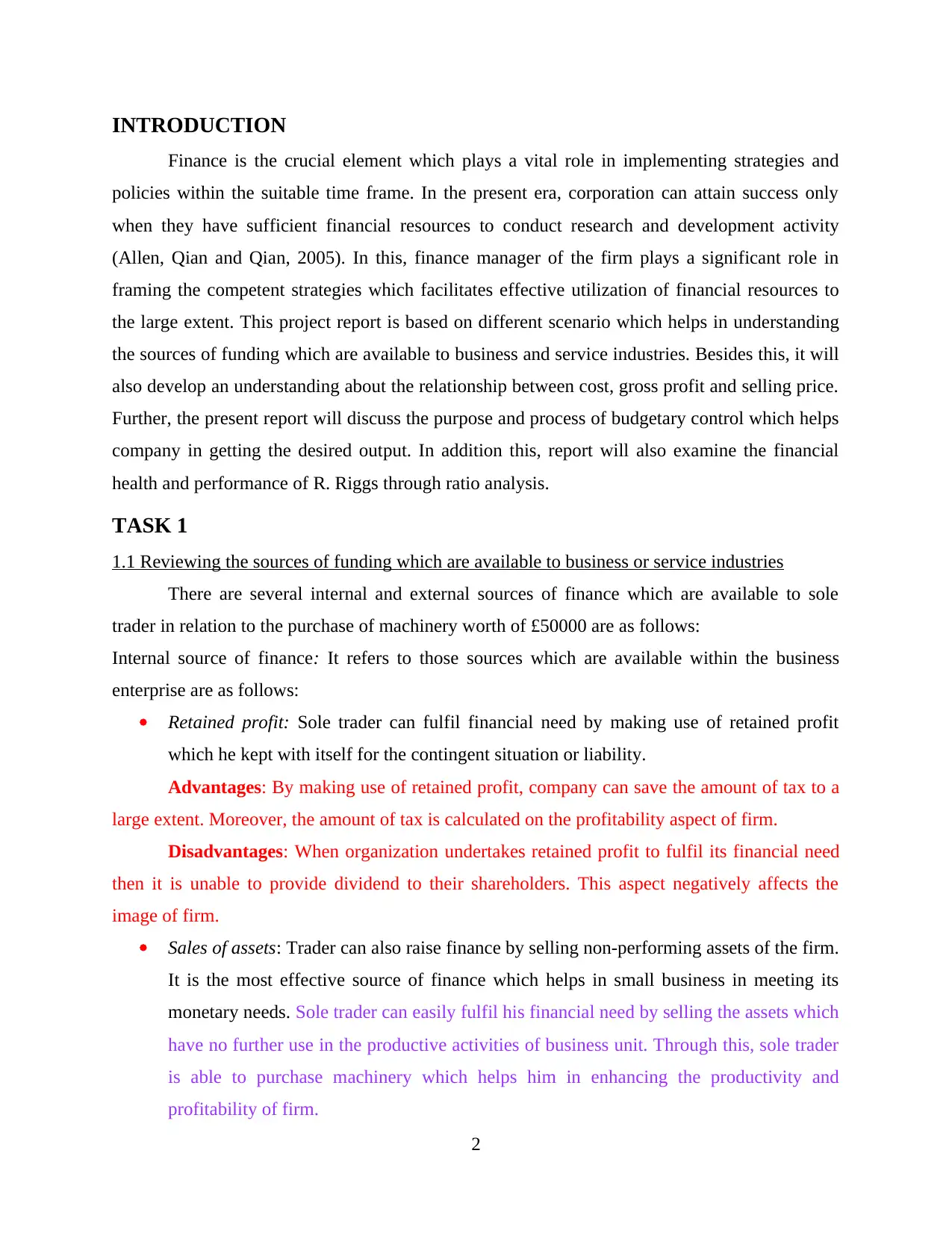
INTRODUCTION
Finance is the crucial element which plays a vital role in implementing strategies and
policies within the suitable time frame. In the present era, corporation can attain success only
when they have sufficient financial resources to conduct research and development activity
(Allen, Qian and Qian, 2005). In this, finance manager of the firm plays a significant role in
framing the competent strategies which facilitates effective utilization of financial resources to
the large extent. This project report is based on different scenario which helps in understanding
the sources of funding which are available to business and service industries. Besides this, it will
also develop an understanding about the relationship between cost, gross profit and selling price.
Further, the present report will discuss the purpose and process of budgetary control which helps
company in getting the desired output. In addition this, report will also examine the financial
health and performance of R. Riggs through ratio analysis.
TASK 1
1.1 Reviewing the sources of funding which are available to business or service industries
There are several internal and external sources of finance which are available to sole
trader in relation to the purchase of machinery worth of £50000 are as follows:
Internal source of finance: It refers to those sources which are available within the business
enterprise are as follows:
Retained profit: Sole trader can fulfil financial need by making use of retained profit
which he kept with itself for the contingent situation or liability.
Advantages: By making use of retained profit, company can save the amount of tax to a
large extent. Moreover, the amount of tax is calculated on the profitability aspect of firm.
Disadvantages: When organization undertakes retained profit to fulfil its financial need
then it is unable to provide dividend to their shareholders. This aspect negatively affects the
image of firm.
Sales of assets: Trader can also raise finance by selling non-performing assets of the firm.
It is the most effective source of finance which helps in small business in meeting its
monetary needs. Sole trader can easily fulfil his financial need by selling the assets which
have no further use in the productive activities of business unit. Through this, sole trader
is able to purchase machinery which helps him in enhancing the productivity and
profitability of firm.
2
Finance is the crucial element which plays a vital role in implementing strategies and
policies within the suitable time frame. In the present era, corporation can attain success only
when they have sufficient financial resources to conduct research and development activity
(Allen, Qian and Qian, 2005). In this, finance manager of the firm plays a significant role in
framing the competent strategies which facilitates effective utilization of financial resources to
the large extent. This project report is based on different scenario which helps in understanding
the sources of funding which are available to business and service industries. Besides this, it will
also develop an understanding about the relationship between cost, gross profit and selling price.
Further, the present report will discuss the purpose and process of budgetary control which helps
company in getting the desired output. In addition this, report will also examine the financial
health and performance of R. Riggs through ratio analysis.
TASK 1
1.1 Reviewing the sources of funding which are available to business or service industries
There are several internal and external sources of finance which are available to sole
trader in relation to the purchase of machinery worth of £50000 are as follows:
Internal source of finance: It refers to those sources which are available within the business
enterprise are as follows:
Retained profit: Sole trader can fulfil financial need by making use of retained profit
which he kept with itself for the contingent situation or liability.
Advantages: By making use of retained profit, company can save the amount of tax to a
large extent. Moreover, the amount of tax is calculated on the profitability aspect of firm.
Disadvantages: When organization undertakes retained profit to fulfil its financial need
then it is unable to provide dividend to their shareholders. This aspect negatively affects the
image of firm.
Sales of assets: Trader can also raise finance by selling non-performing assets of the firm.
It is the most effective source of finance which helps in small business in meeting its
monetary needs. Sole trader can easily fulfil his financial need by selling the assets which
have no further use in the productive activities of business unit. Through this, sole trader
is able to purchase machinery which helps him in enhancing the productivity and
profitability of firm.
2
⊘ This is a preview!⊘
Do you want full access?
Subscribe today to unlock all pages.

Trusted by 1+ million students worldwide
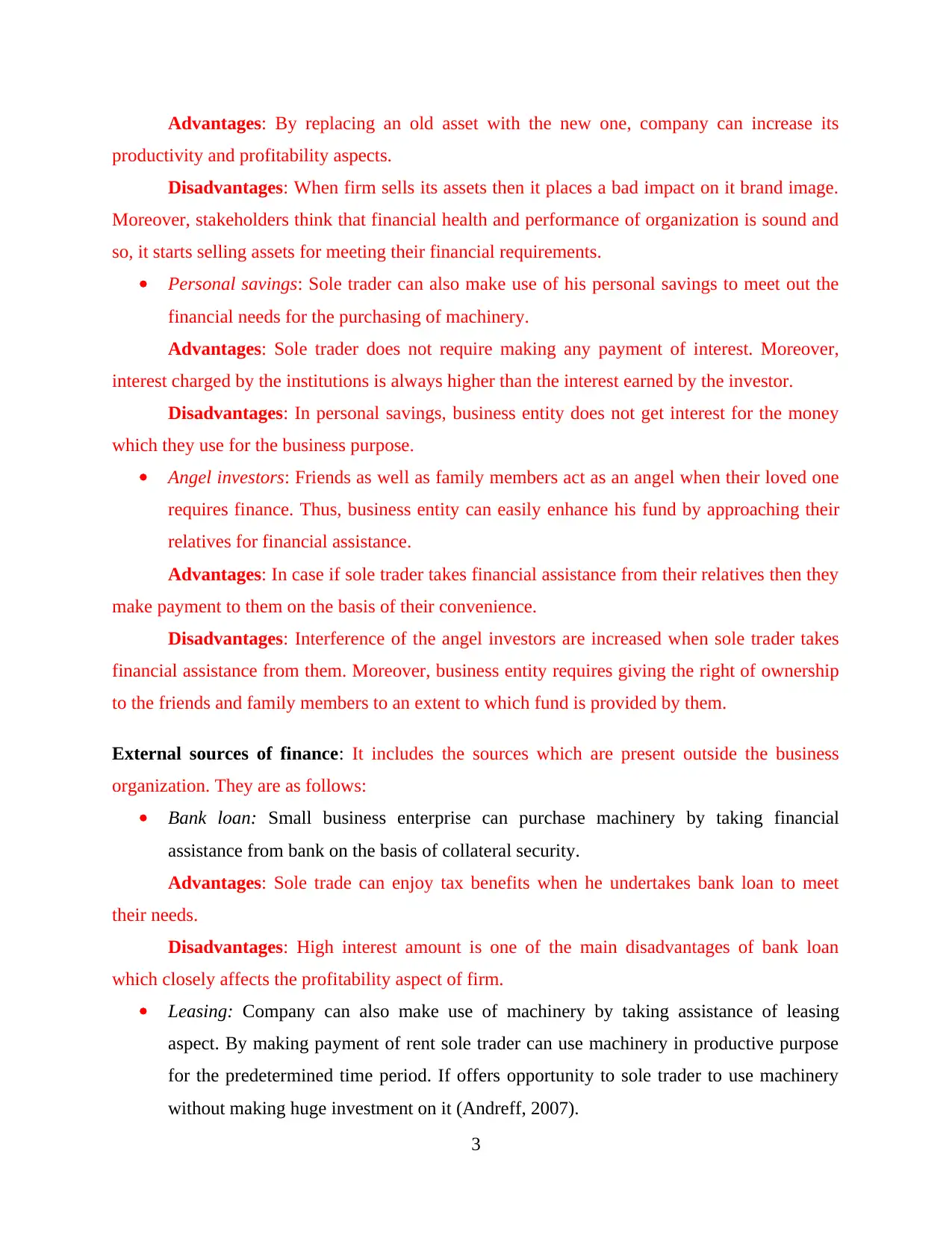
Advantages: By replacing an old asset with the new one, company can increase its
productivity and profitability aspects.
Disadvantages: When firm sells its assets then it places a bad impact on it brand image.
Moreover, stakeholders think that financial health and performance of organization is sound and
so, it starts selling assets for meeting their financial requirements.
Personal savings: Sole trader can also make use of his personal savings to meet out the
financial needs for the purchasing of machinery.
Advantages: Sole trader does not require making any payment of interest. Moreover,
interest charged by the institutions is always higher than the interest earned by the investor.
Disadvantages: In personal savings, business entity does not get interest for the money
which they use for the business purpose.
Angel investors: Friends as well as family members act as an angel when their loved one
requires finance. Thus, business entity can easily enhance his fund by approaching their
relatives for financial assistance.
Advantages: In case if sole trader takes financial assistance from their relatives then they
make payment to them on the basis of their convenience.
Disadvantages: Interference of the angel investors are increased when sole trader takes
financial assistance from them. Moreover, business entity requires giving the right of ownership
to the friends and family members to an extent to which fund is provided by them.
External sources of finance: It includes the sources which are present outside the business
organization. They are as follows:
Bank loan: Small business enterprise can purchase machinery by taking financial
assistance from bank on the basis of collateral security.
Advantages: Sole trade can enjoy tax benefits when he undertakes bank loan to meet
their needs.
Disadvantages: High interest amount is one of the main disadvantages of bank loan
which closely affects the profitability aspect of firm.
Leasing: Company can also make use of machinery by taking assistance of leasing
aspect. By making payment of rent sole trader can use machinery in productive purpose
for the predetermined time period. If offers opportunity to sole trader to use machinery
without making huge investment on it (Andreff, 2007).
3
productivity and profitability aspects.
Disadvantages: When firm sells its assets then it places a bad impact on it brand image.
Moreover, stakeholders think that financial health and performance of organization is sound and
so, it starts selling assets for meeting their financial requirements.
Personal savings: Sole trader can also make use of his personal savings to meet out the
financial needs for the purchasing of machinery.
Advantages: Sole trader does not require making any payment of interest. Moreover,
interest charged by the institutions is always higher than the interest earned by the investor.
Disadvantages: In personal savings, business entity does not get interest for the money
which they use for the business purpose.
Angel investors: Friends as well as family members act as an angel when their loved one
requires finance. Thus, business entity can easily enhance his fund by approaching their
relatives for financial assistance.
Advantages: In case if sole trader takes financial assistance from their relatives then they
make payment to them on the basis of their convenience.
Disadvantages: Interference of the angel investors are increased when sole trader takes
financial assistance from them. Moreover, business entity requires giving the right of ownership
to the friends and family members to an extent to which fund is provided by them.
External sources of finance: It includes the sources which are present outside the business
organization. They are as follows:
Bank loan: Small business enterprise can purchase machinery by taking financial
assistance from bank on the basis of collateral security.
Advantages: Sole trade can enjoy tax benefits when he undertakes bank loan to meet
their needs.
Disadvantages: High interest amount is one of the main disadvantages of bank loan
which closely affects the profitability aspect of firm.
Leasing: Company can also make use of machinery by taking assistance of leasing
aspect. By making payment of rent sole trader can use machinery in productive purpose
for the predetermined time period. If offers opportunity to sole trader to use machinery
without making huge investment on it (Andreff, 2007).
3
Paraphrase This Document
Need a fresh take? Get an instant paraphrase of this document with our AI Paraphraser
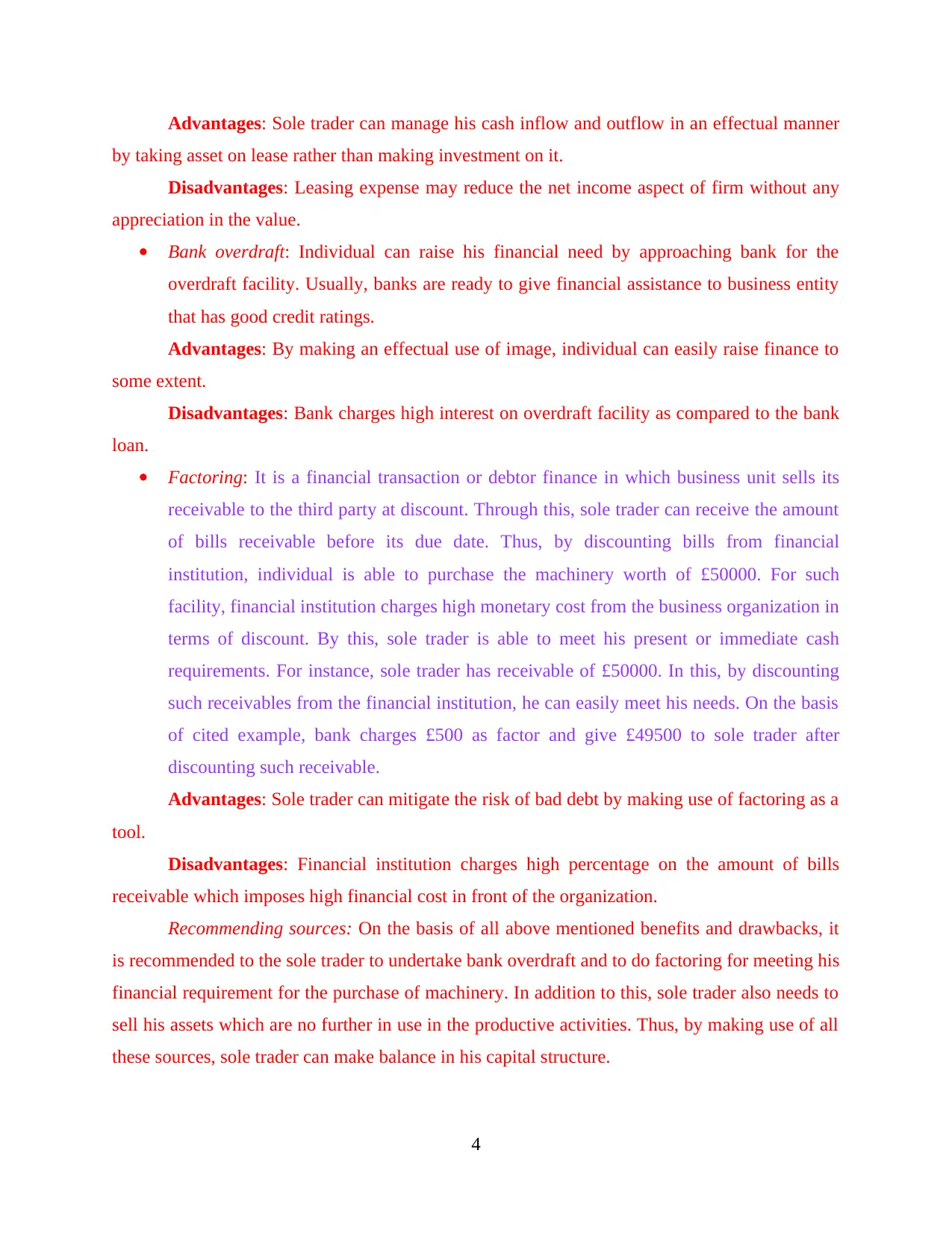
Advantages: Sole trader can manage his cash inflow and outflow in an effectual manner
by taking asset on lease rather than making investment on it.
Disadvantages: Leasing expense may reduce the net income aspect of firm without any
appreciation in the value.
Bank overdraft: Individual can raise his financial need by approaching bank for the
overdraft facility. Usually, banks are ready to give financial assistance to business entity
that has good credit ratings.
Advantages: By making an effectual use of image, individual can easily raise finance to
some extent.
Disadvantages: Bank charges high interest on overdraft facility as compared to the bank
loan.
Factoring: It is a financial transaction or debtor finance in which business unit sells its
receivable to the third party at discount. Through this, sole trader can receive the amount
of bills receivable before its due date. Thus, by discounting bills from financial
institution, individual is able to purchase the machinery worth of £50000. For such
facility, financial institution charges high monetary cost from the business organization in
terms of discount. By this, sole trader is able to meet his present or immediate cash
requirements. For instance, sole trader has receivable of £50000. In this, by discounting
such receivables from the financial institution, he can easily meet his needs. On the basis
of cited example, bank charges £500 as factor and give £49500 to sole trader after
discounting such receivable.
Advantages: Sole trader can mitigate the risk of bad debt by making use of factoring as a
tool.
Disadvantages: Financial institution charges high percentage on the amount of bills
receivable which imposes high financial cost in front of the organization.
Recommending sources: On the basis of all above mentioned benefits and drawbacks, it
is recommended to the sole trader to undertake bank overdraft and to do factoring for meeting his
financial requirement for the purchase of machinery. In addition to this, sole trader also needs to
sell his assets which are no further in use in the productive activities. Thus, by making use of all
these sources, sole trader can make balance in his capital structure.
4
by taking asset on lease rather than making investment on it.
Disadvantages: Leasing expense may reduce the net income aspect of firm without any
appreciation in the value.
Bank overdraft: Individual can raise his financial need by approaching bank for the
overdraft facility. Usually, banks are ready to give financial assistance to business entity
that has good credit ratings.
Advantages: By making an effectual use of image, individual can easily raise finance to
some extent.
Disadvantages: Bank charges high interest on overdraft facility as compared to the bank
loan.
Factoring: It is a financial transaction or debtor finance in which business unit sells its
receivable to the third party at discount. Through this, sole trader can receive the amount
of bills receivable before its due date. Thus, by discounting bills from financial
institution, individual is able to purchase the machinery worth of £50000. For such
facility, financial institution charges high monetary cost from the business organization in
terms of discount. By this, sole trader is able to meet his present or immediate cash
requirements. For instance, sole trader has receivable of £50000. In this, by discounting
such receivables from the financial institution, he can easily meet his needs. On the basis
of cited example, bank charges £500 as factor and give £49500 to sole trader after
discounting such receivable.
Advantages: Sole trader can mitigate the risk of bad debt by making use of factoring as a
tool.
Disadvantages: Financial institution charges high percentage on the amount of bills
receivable which imposes high financial cost in front of the organization.
Recommending sources: On the basis of all above mentioned benefits and drawbacks, it
is recommended to the sole trader to undertake bank overdraft and to do factoring for meeting his
financial requirement for the purchase of machinery. In addition to this, sole trader also needs to
sell his assets which are no further in use in the productive activities. Thus, by making use of all
these sources, sole trader can make balance in his capital structure.
4
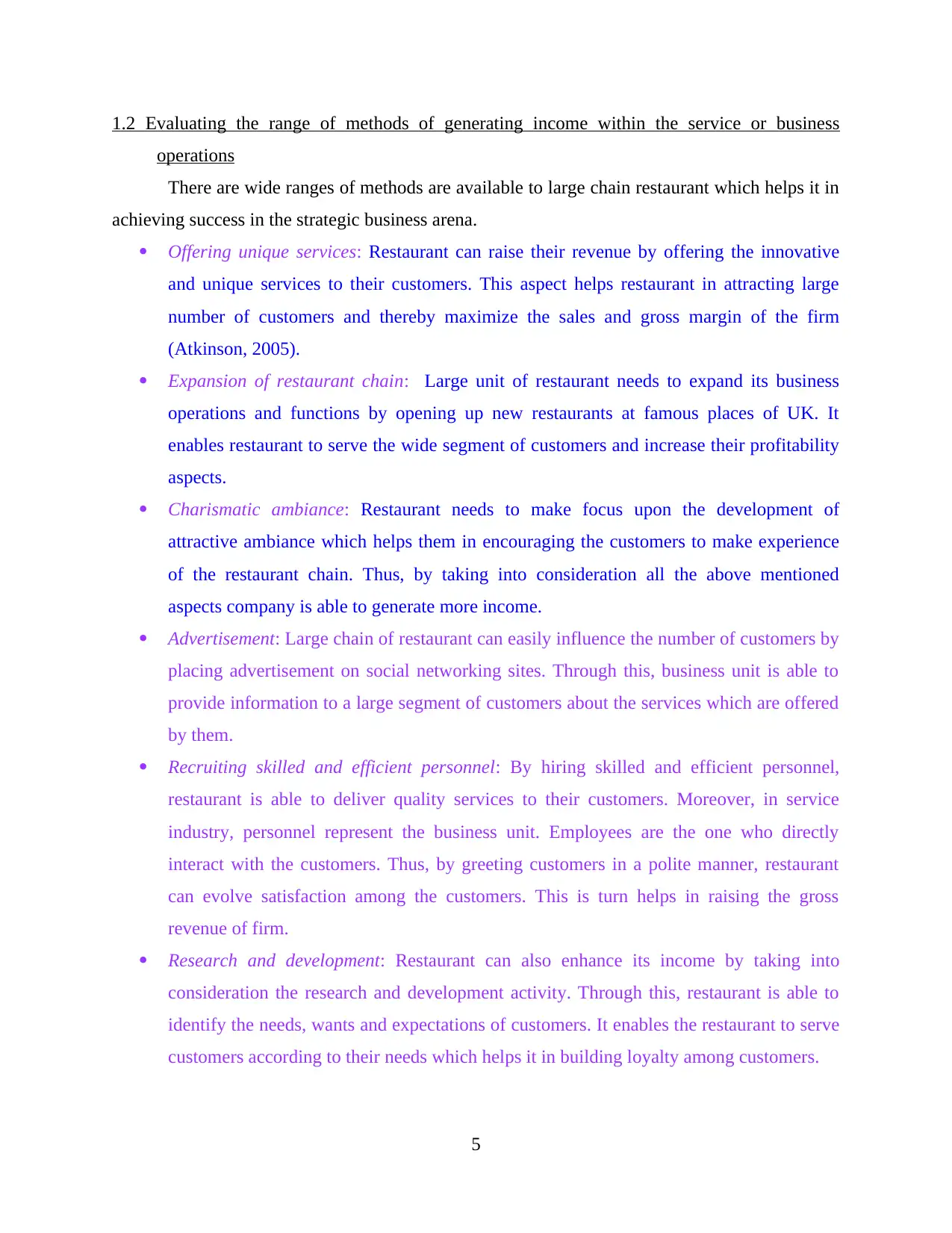
1.2 Evaluating the range of methods of generating income within the service or business
operations
There are wide ranges of methods are available to large chain restaurant which helps it in
achieving success in the strategic business arena.
Offering unique services: Restaurant can raise their revenue by offering the innovative
and unique services to their customers. This aspect helps restaurant in attracting large
number of customers and thereby maximize the sales and gross margin of the firm
(Atkinson, 2005).
Expansion of restaurant chain: Large unit of restaurant needs to expand its business
operations and functions by opening up new restaurants at famous places of UK. It
enables restaurant to serve the wide segment of customers and increase their profitability
aspects.
Charismatic ambiance: Restaurant needs to make focus upon the development of
attractive ambiance which helps them in encouraging the customers to make experience
of the restaurant chain. Thus, by taking into consideration all the above mentioned
aspects company is able to generate more income.
Advertisement: Large chain of restaurant can easily influence the number of customers by
placing advertisement on social networking sites. Through this, business unit is able to
provide information to a large segment of customers about the services which are offered
by them.
Recruiting skilled and efficient personnel: By hiring skilled and efficient personnel,
restaurant is able to deliver quality services to their customers. Moreover, in service
industry, personnel represent the business unit. Employees are the one who directly
interact with the customers. Thus, by greeting customers in a polite manner, restaurant
can evolve satisfaction among the customers. This is turn helps in raising the gross
revenue of firm.
Research and development: Restaurant can also enhance its income by taking into
consideration the research and development activity. Through this, restaurant is able to
identify the needs, wants and expectations of customers. It enables the restaurant to serve
customers according to their needs which helps it in building loyalty among customers.
5
operations
There are wide ranges of methods are available to large chain restaurant which helps it in
achieving success in the strategic business arena.
Offering unique services: Restaurant can raise their revenue by offering the innovative
and unique services to their customers. This aspect helps restaurant in attracting large
number of customers and thereby maximize the sales and gross margin of the firm
(Atkinson, 2005).
Expansion of restaurant chain: Large unit of restaurant needs to expand its business
operations and functions by opening up new restaurants at famous places of UK. It
enables restaurant to serve the wide segment of customers and increase their profitability
aspects.
Charismatic ambiance: Restaurant needs to make focus upon the development of
attractive ambiance which helps them in encouraging the customers to make experience
of the restaurant chain. Thus, by taking into consideration all the above mentioned
aspects company is able to generate more income.
Advertisement: Large chain of restaurant can easily influence the number of customers by
placing advertisement on social networking sites. Through this, business unit is able to
provide information to a large segment of customers about the services which are offered
by them.
Recruiting skilled and efficient personnel: By hiring skilled and efficient personnel,
restaurant is able to deliver quality services to their customers. Moreover, in service
industry, personnel represent the business unit. Employees are the one who directly
interact with the customers. Thus, by greeting customers in a polite manner, restaurant
can evolve satisfaction among the customers. This is turn helps in raising the gross
revenue of firm.
Research and development: Restaurant can also enhance its income by taking into
consideration the research and development activity. Through this, restaurant is able to
identify the needs, wants and expectations of customers. It enables the restaurant to serve
customers according to their needs which helps it in building loyalty among customers.
5
⊘ This is a preview!⊘
Do you want full access?
Subscribe today to unlock all pages.

Trusted by 1+ million students worldwide
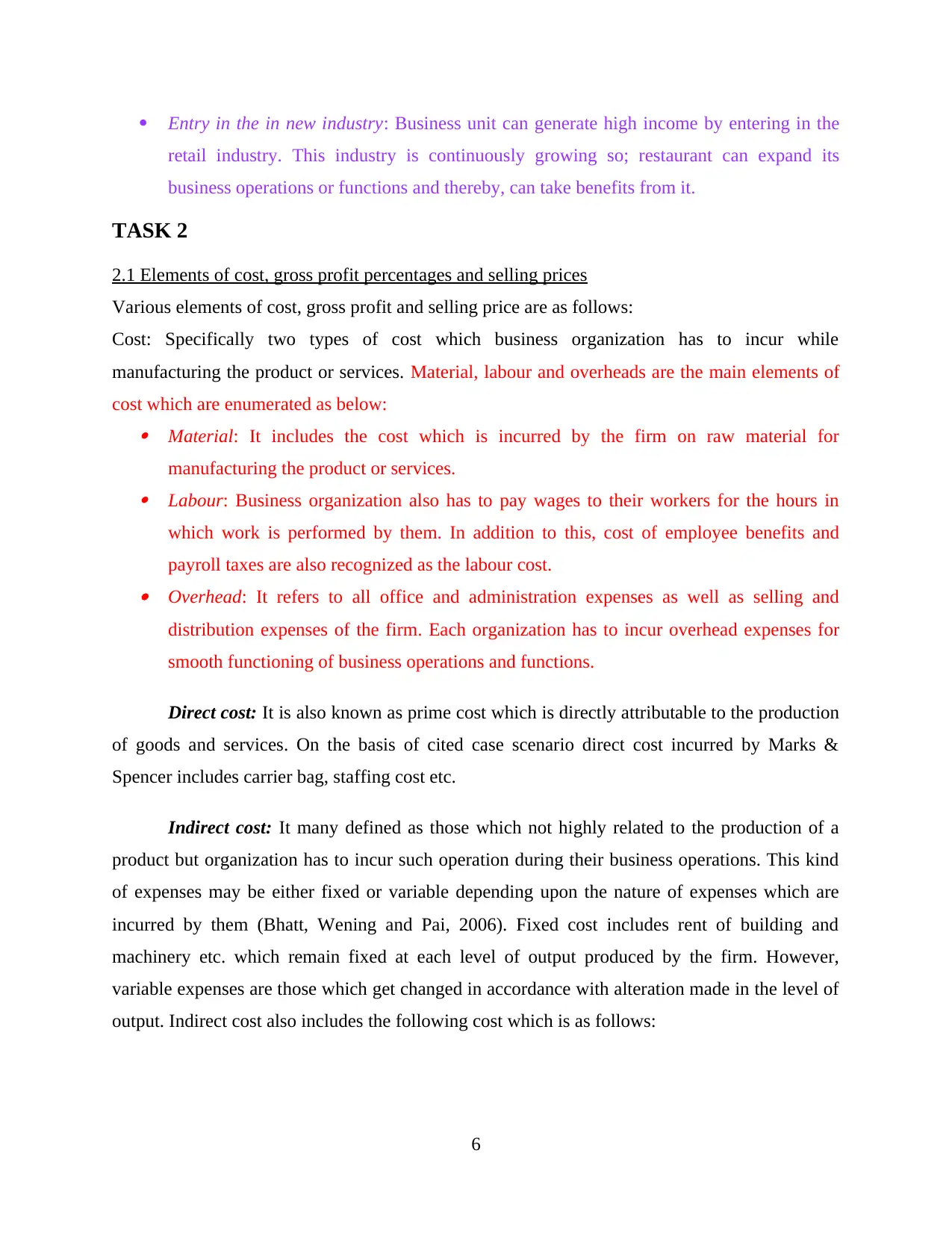
Entry in the in new industry: Business unit can generate high income by entering in the
retail industry. This industry is continuously growing so; restaurant can expand its
business operations or functions and thereby, can take benefits from it.
TASK 2
2.1 Elements of cost, gross profit percentages and selling prices
Various elements of cost, gross profit and selling price are as follows:
Cost: Specifically two types of cost which business organization has to incur while
manufacturing the product or services. Material, labour and overheads are the main elements of
cost which are enumerated as below: Material: It includes the cost which is incurred by the firm on raw material for
manufacturing the product or services. Labour: Business organization also has to pay wages to their workers for the hours in
which work is performed by them. In addition to this, cost of employee benefits and
payroll taxes are also recognized as the labour cost. Overhead: It refers to all office and administration expenses as well as selling and
distribution expenses of the firm. Each organization has to incur overhead expenses for
smooth functioning of business operations and functions.
Direct cost: It is also known as prime cost which is directly attributable to the production
of goods and services. On the basis of cited case scenario direct cost incurred by Marks &
Spencer includes carrier bag, staffing cost etc.
Indirect cost: It many defined as those which not highly related to the production of a
product but organization has to incur such operation during their business operations. This kind
of expenses may be either fixed or variable depending upon the nature of expenses which are
incurred by them (Bhatt, Wening and Pai, 2006). Fixed cost includes rent of building and
machinery etc. which remain fixed at each level of output produced by the firm. However,
variable expenses are those which get changed in accordance with alteration made in the level of
output. Indirect cost also includes the following cost which is as follows:
6
retail industry. This industry is continuously growing so; restaurant can expand its
business operations or functions and thereby, can take benefits from it.
TASK 2
2.1 Elements of cost, gross profit percentages and selling prices
Various elements of cost, gross profit and selling price are as follows:
Cost: Specifically two types of cost which business organization has to incur while
manufacturing the product or services. Material, labour and overheads are the main elements of
cost which are enumerated as below: Material: It includes the cost which is incurred by the firm on raw material for
manufacturing the product or services. Labour: Business organization also has to pay wages to their workers for the hours in
which work is performed by them. In addition to this, cost of employee benefits and
payroll taxes are also recognized as the labour cost. Overhead: It refers to all office and administration expenses as well as selling and
distribution expenses of the firm. Each organization has to incur overhead expenses for
smooth functioning of business operations and functions.
Direct cost: It is also known as prime cost which is directly attributable to the production
of goods and services. On the basis of cited case scenario direct cost incurred by Marks &
Spencer includes carrier bag, staffing cost etc.
Indirect cost: It many defined as those which not highly related to the production of a
product but organization has to incur such operation during their business operations. This kind
of expenses may be either fixed or variable depending upon the nature of expenses which are
incurred by them (Bhatt, Wening and Pai, 2006). Fixed cost includes rent of building and
machinery etc. which remain fixed at each level of output produced by the firm. However,
variable expenses are those which get changed in accordance with alteration made in the level of
output. Indirect cost also includes the following cost which is as follows:
6
Paraphrase This Document
Need a fresh take? Get an instant paraphrase of this document with our AI Paraphraser
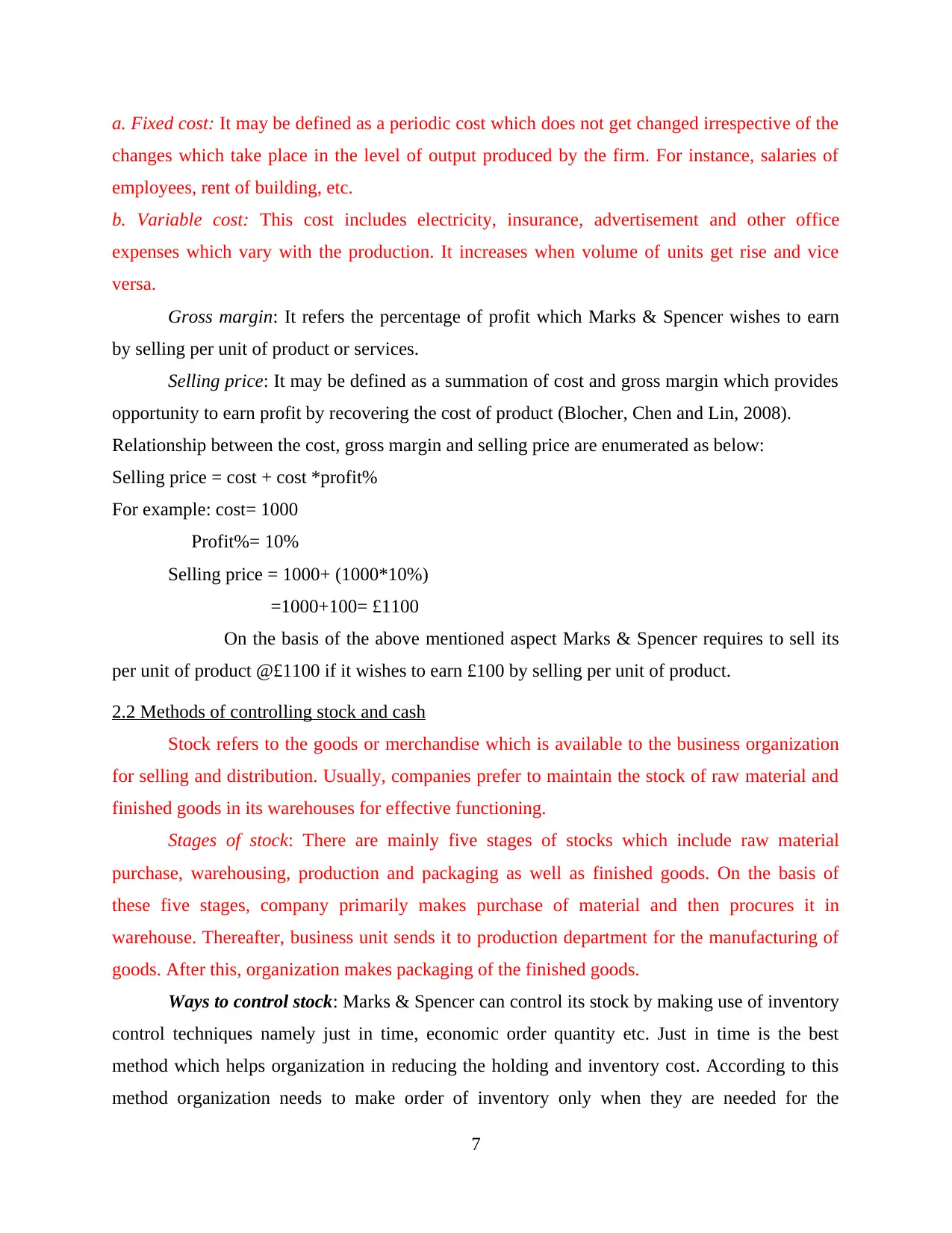
a. Fixed cost: It may be defined as a periodic cost which does not get changed irrespective of the
changes which take place in the level of output produced by the firm. For instance, salaries of
employees, rent of building, etc.
b. Variable cost: This cost includes electricity, insurance, advertisement and other office
expenses which vary with the production. It increases when volume of units get rise and vice
versa.
Gross margin: It refers the percentage of profit which Marks & Spencer wishes to earn
by selling per unit of product or services.
Selling price: It may be defined as a summation of cost and gross margin which provides
opportunity to earn profit by recovering the cost of product (Blocher, Chen and Lin, 2008).
Relationship between the cost, gross margin and selling price are enumerated as below:
Selling price = cost + cost *profit%
For example: cost= 1000
Profit%= 10%
Selling price = 1000+ (1000*10%)
=1000+100= £1100
On the basis of the above mentioned aspect Marks & Spencer requires to sell its
per unit of product @£1100 if it wishes to earn £100 by selling per unit of product.
2.2 Methods of controlling stock and cash
Stock refers to the goods or merchandise which is available to the business organization
for selling and distribution. Usually, companies prefer to maintain the stock of raw material and
finished goods in its warehouses for effective functioning.
Stages of stock: There are mainly five stages of stocks which include raw material
purchase, warehousing, production and packaging as well as finished goods. On the basis of
these five stages, company primarily makes purchase of material and then procures it in
warehouse. Thereafter, business unit sends it to production department for the manufacturing of
goods. After this, organization makes packaging of the finished goods.
Ways to control stock: Marks & Spencer can control its stock by making use of inventory
control techniques namely just in time, economic order quantity etc. Just in time is the best
method which helps organization in reducing the holding and inventory cost. According to this
method organization needs to make order of inventory only when they are needed for the
7
changes which take place in the level of output produced by the firm. For instance, salaries of
employees, rent of building, etc.
b. Variable cost: This cost includes electricity, insurance, advertisement and other office
expenses which vary with the production. It increases when volume of units get rise and vice
versa.
Gross margin: It refers the percentage of profit which Marks & Spencer wishes to earn
by selling per unit of product or services.
Selling price: It may be defined as a summation of cost and gross margin which provides
opportunity to earn profit by recovering the cost of product (Blocher, Chen and Lin, 2008).
Relationship between the cost, gross margin and selling price are enumerated as below:
Selling price = cost + cost *profit%
For example: cost= 1000
Profit%= 10%
Selling price = 1000+ (1000*10%)
=1000+100= £1100
On the basis of the above mentioned aspect Marks & Spencer requires to sell its
per unit of product @£1100 if it wishes to earn £100 by selling per unit of product.
2.2 Methods of controlling stock and cash
Stock refers to the goods or merchandise which is available to the business organization
for selling and distribution. Usually, companies prefer to maintain the stock of raw material and
finished goods in its warehouses for effective functioning.
Stages of stock: There are mainly five stages of stocks which include raw material
purchase, warehousing, production and packaging as well as finished goods. On the basis of
these five stages, company primarily makes purchase of material and then procures it in
warehouse. Thereafter, business unit sends it to production department for the manufacturing of
goods. After this, organization makes packaging of the finished goods.
Ways to control stock: Marks & Spencer can control its stock by making use of inventory
control techniques namely just in time, economic order quantity etc. Just in time is the best
method which helps organization in reducing the holding and inventory cost. According to this
method organization needs to make order of inventory only when they are needed for the
7
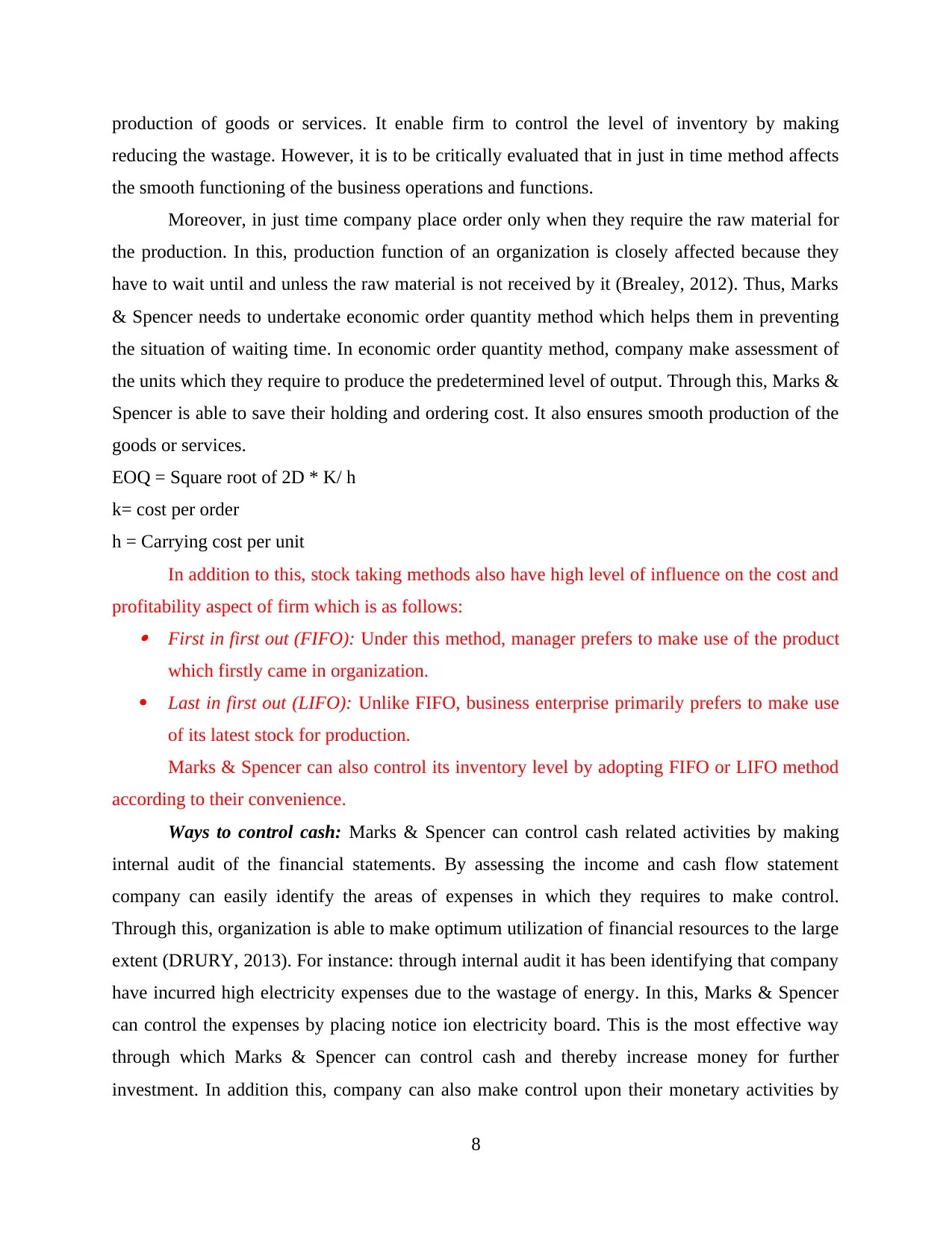
production of goods or services. It enable firm to control the level of inventory by making
reducing the wastage. However, it is to be critically evaluated that in just in time method affects
the smooth functioning of the business operations and functions.
Moreover, in just time company place order only when they require the raw material for
the production. In this, production function of an organization is closely affected because they
have to wait until and unless the raw material is not received by it (Brealey, 2012). Thus, Marks
& Spencer needs to undertake economic order quantity method which helps them in preventing
the situation of waiting time. In economic order quantity method, company make assessment of
the units which they require to produce the predetermined level of output. Through this, Marks &
Spencer is able to save their holding and ordering cost. It also ensures smooth production of the
goods or services.
EOQ = Square root of 2D * K/ h
k= cost per order
h = Carrying cost per unit
In addition to this, stock taking methods also have high level of influence on the cost and
profitability aspect of firm which is as follows: First in first out (FIFO): Under this method, manager prefers to make use of the product
which firstly came in organization.
Last in first out (LIFO): Unlike FIFO, business enterprise primarily prefers to make use
of its latest stock for production.
Marks & Spencer can also control its inventory level by adopting FIFO or LIFO method
according to their convenience.
Ways to control cash: Marks & Spencer can control cash related activities by making
internal audit of the financial statements. By assessing the income and cash flow statement
company can easily identify the areas of expenses in which they requires to make control.
Through this, organization is able to make optimum utilization of financial resources to the large
extent (DRURY, 2013). For instance: through internal audit it has been identifying that company
have incurred high electricity expenses due to the wastage of energy. In this, Marks & Spencer
can control the expenses by placing notice ion electricity board. This is the most effective way
through which Marks & Spencer can control cash and thereby increase money for further
investment. In addition this, company can also make control upon their monetary activities by
8
reducing the wastage. However, it is to be critically evaluated that in just in time method affects
the smooth functioning of the business operations and functions.
Moreover, in just time company place order only when they require the raw material for
the production. In this, production function of an organization is closely affected because they
have to wait until and unless the raw material is not received by it (Brealey, 2012). Thus, Marks
& Spencer needs to undertake economic order quantity method which helps them in preventing
the situation of waiting time. In economic order quantity method, company make assessment of
the units which they require to produce the predetermined level of output. Through this, Marks &
Spencer is able to save their holding and ordering cost. It also ensures smooth production of the
goods or services.
EOQ = Square root of 2D * K/ h
k= cost per order
h = Carrying cost per unit
In addition to this, stock taking methods also have high level of influence on the cost and
profitability aspect of firm which is as follows: First in first out (FIFO): Under this method, manager prefers to make use of the product
which firstly came in organization.
Last in first out (LIFO): Unlike FIFO, business enterprise primarily prefers to make use
of its latest stock for production.
Marks & Spencer can also control its inventory level by adopting FIFO or LIFO method
according to their convenience.
Ways to control cash: Marks & Spencer can control cash related activities by making
internal audit of the financial statements. By assessing the income and cash flow statement
company can easily identify the areas of expenses in which they requires to make control.
Through this, organization is able to make optimum utilization of financial resources to the large
extent (DRURY, 2013). For instance: through internal audit it has been identifying that company
have incurred high electricity expenses due to the wastage of energy. In this, Marks & Spencer
can control the expenses by placing notice ion electricity board. This is the most effective way
through which Marks & Spencer can control cash and thereby increase money for further
investment. In addition this, company can also make control upon their monetary activities by
8
⊘ This is a preview!⊘
Do you want full access?
Subscribe today to unlock all pages.

Trusted by 1+ million students worldwide
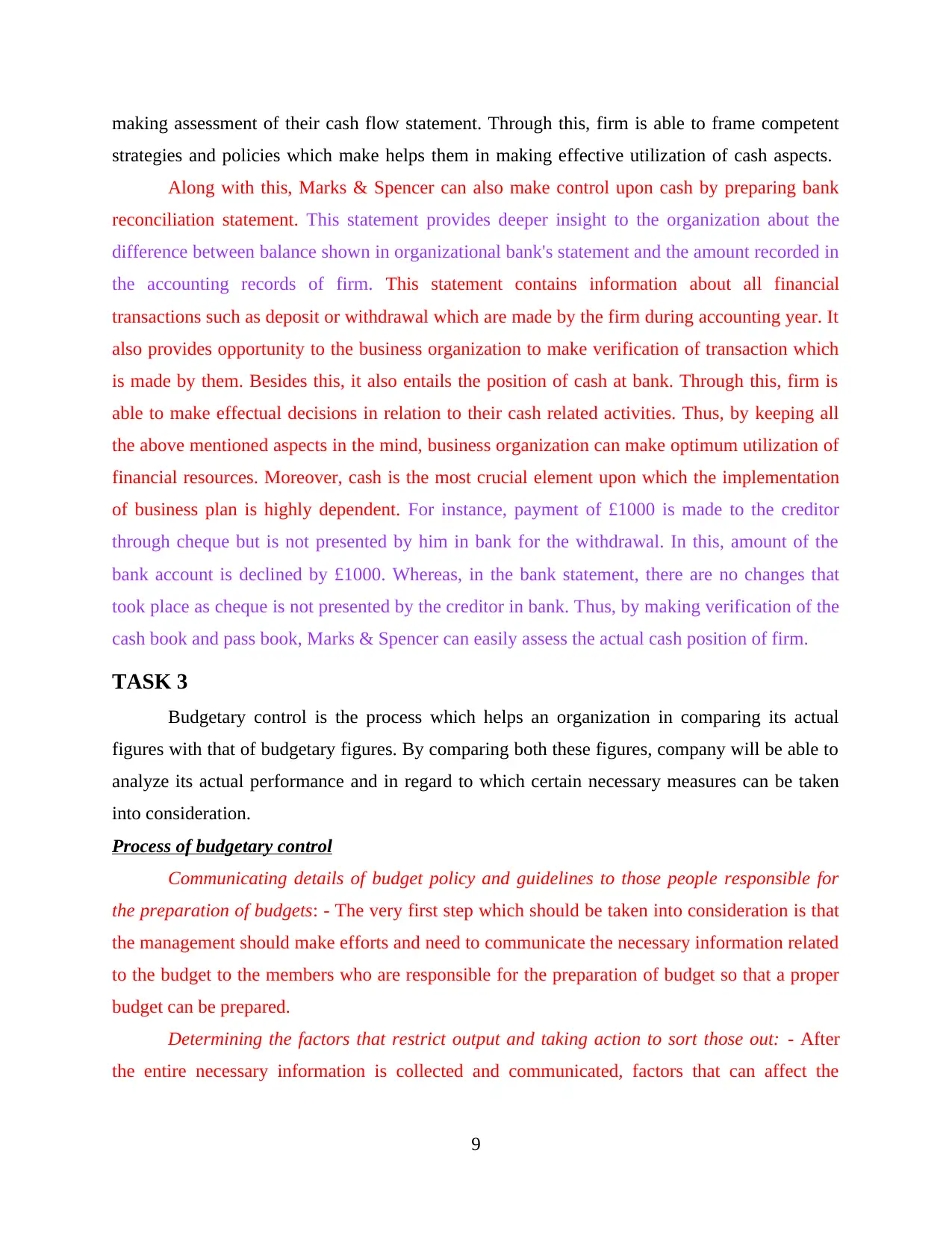
making assessment of their cash flow statement. Through this, firm is able to frame competent
strategies and policies which make helps them in making effective utilization of cash aspects.
Along with this, Marks & Spencer can also make control upon cash by preparing bank
reconciliation statement. This statement provides deeper insight to the organization about the
difference between balance shown in organizational bank's statement and the amount recorded in
the accounting records of firm. This statement contains information about all financial
transactions such as deposit or withdrawal which are made by the firm during accounting year. It
also provides opportunity to the business organization to make verification of transaction which
is made by them. Besides this, it also entails the position of cash at bank. Through this, firm is
able to make effectual decisions in relation to their cash related activities. Thus, by keeping all
the above mentioned aspects in the mind, business organization can make optimum utilization of
financial resources. Moreover, cash is the most crucial element upon which the implementation
of business plan is highly dependent. For instance, payment of £1000 is made to the creditor
through cheque but is not presented by him in bank for the withdrawal. In this, amount of the
bank account is declined by £1000. Whereas, in the bank statement, there are no changes that
took place as cheque is not presented by the creditor in bank. Thus, by making verification of the
cash book and pass book, Marks & Spencer can easily assess the actual cash position of firm.
TASK 3
Budgetary control is the process which helps an organization in comparing its actual
figures with that of budgetary figures. By comparing both these figures, company will be able to
analyze its actual performance and in regard to which certain necessary measures can be taken
into consideration.
Process of budgetary control
Communicating details of budget policy and guidelines to those people responsible for
the preparation of budgets: - The very first step which should be taken into consideration is that
the management should make efforts and need to communicate the necessary information related
to the budget to the members who are responsible for the preparation of budget so that a proper
budget can be prepared.
Determining the factors that restrict output and taking action to sort those out: - After
the entire necessary information is collected and communicated, factors that can affect the
9
strategies and policies which make helps them in making effective utilization of cash aspects.
Along with this, Marks & Spencer can also make control upon cash by preparing bank
reconciliation statement. This statement provides deeper insight to the organization about the
difference between balance shown in organizational bank's statement and the amount recorded in
the accounting records of firm. This statement contains information about all financial
transactions such as deposit or withdrawal which are made by the firm during accounting year. It
also provides opportunity to the business organization to make verification of transaction which
is made by them. Besides this, it also entails the position of cash at bank. Through this, firm is
able to make effectual decisions in relation to their cash related activities. Thus, by keeping all
the above mentioned aspects in the mind, business organization can make optimum utilization of
financial resources. Moreover, cash is the most crucial element upon which the implementation
of business plan is highly dependent. For instance, payment of £1000 is made to the creditor
through cheque but is not presented by him in bank for the withdrawal. In this, amount of the
bank account is declined by £1000. Whereas, in the bank statement, there are no changes that
took place as cheque is not presented by the creditor in bank. Thus, by making verification of the
cash book and pass book, Marks & Spencer can easily assess the actual cash position of firm.
TASK 3
Budgetary control is the process which helps an organization in comparing its actual
figures with that of budgetary figures. By comparing both these figures, company will be able to
analyze its actual performance and in regard to which certain necessary measures can be taken
into consideration.
Process of budgetary control
Communicating details of budget policy and guidelines to those people responsible for
the preparation of budgets: - The very first step which should be taken into consideration is that
the management should make efforts and need to communicate the necessary information related
to the budget to the members who are responsible for the preparation of budget so that a proper
budget can be prepared.
Determining the factors that restrict output and taking action to sort those out: - After
the entire necessary information is collected and communicated, factors that can affect the
9
Paraphrase This Document
Need a fresh take? Get an instant paraphrase of this document with our AI Paraphraser
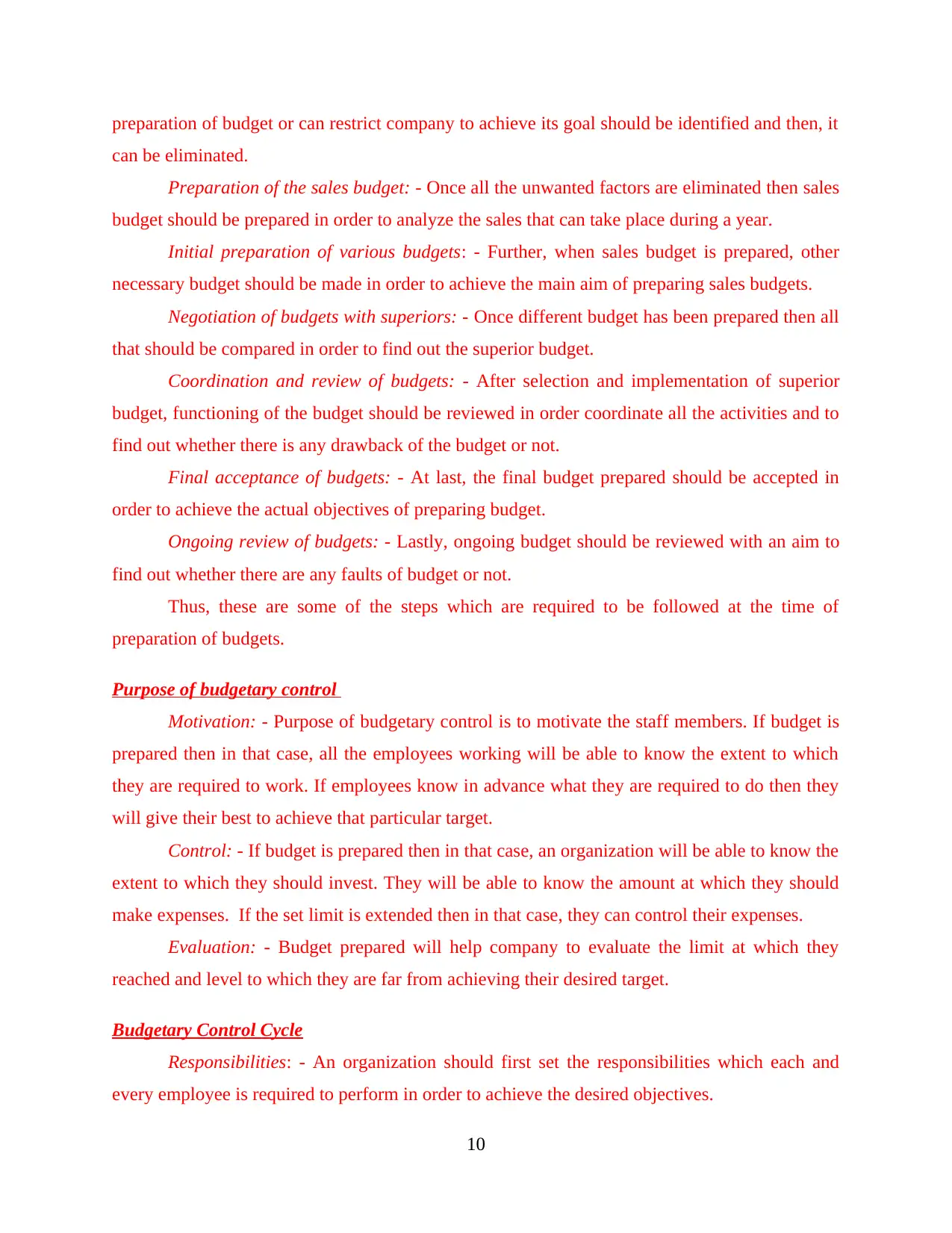
preparation of budget or can restrict company to achieve its goal should be identified and then, it
can be eliminated.
Preparation of the sales budget: - Once all the unwanted factors are eliminated then sales
budget should be prepared in order to analyze the sales that can take place during a year.
Initial preparation of various budgets: - Further, when sales budget is prepared, other
necessary budget should be made in order to achieve the main aim of preparing sales budgets.
Negotiation of budgets with superiors: - Once different budget has been prepared then all
that should be compared in order to find out the superior budget.
Coordination and review of budgets: - After selection and implementation of superior
budget, functioning of the budget should be reviewed in order coordinate all the activities and to
find out whether there is any drawback of the budget or not.
Final acceptance of budgets: - At last, the final budget prepared should be accepted in
order to achieve the actual objectives of preparing budget.
Ongoing review of budgets: - Lastly, ongoing budget should be reviewed with an aim to
find out whether there are any faults of budget or not.
Thus, these are some of the steps which are required to be followed at the time of
preparation of budgets.
Purpose of budgetary control
Motivation: - Purpose of budgetary control is to motivate the staff members. If budget is
prepared then in that case, all the employees working will be able to know the extent to which
they are required to work. If employees know in advance what they are required to do then they
will give their best to achieve that particular target.
Control: - If budget is prepared then in that case, an organization will be able to know the
extent to which they should invest. They will be able to know the amount at which they should
make expenses. If the set limit is extended then in that case, they can control their expenses.
Evaluation: - Budget prepared will help company to evaluate the limit at which they
reached and level to which they are far from achieving their desired target.
Budgetary Control Cycle
Responsibilities: - An organization should first set the responsibilities which each and
every employee is required to perform in order to achieve the desired objectives.
10
can be eliminated.
Preparation of the sales budget: - Once all the unwanted factors are eliminated then sales
budget should be prepared in order to analyze the sales that can take place during a year.
Initial preparation of various budgets: - Further, when sales budget is prepared, other
necessary budget should be made in order to achieve the main aim of preparing sales budgets.
Negotiation of budgets with superiors: - Once different budget has been prepared then all
that should be compared in order to find out the superior budget.
Coordination and review of budgets: - After selection and implementation of superior
budget, functioning of the budget should be reviewed in order coordinate all the activities and to
find out whether there is any drawback of the budget or not.
Final acceptance of budgets: - At last, the final budget prepared should be accepted in
order to achieve the actual objectives of preparing budget.
Ongoing review of budgets: - Lastly, ongoing budget should be reviewed with an aim to
find out whether there are any faults of budget or not.
Thus, these are some of the steps which are required to be followed at the time of
preparation of budgets.
Purpose of budgetary control
Motivation: - Purpose of budgetary control is to motivate the staff members. If budget is
prepared then in that case, all the employees working will be able to know the extent to which
they are required to work. If employees know in advance what they are required to do then they
will give their best to achieve that particular target.
Control: - If budget is prepared then in that case, an organization will be able to know the
extent to which they should invest. They will be able to know the amount at which they should
make expenses. If the set limit is extended then in that case, they can control their expenses.
Evaluation: - Budget prepared will help company to evaluate the limit at which they
reached and level to which they are far from achieving their desired target.
Budgetary Control Cycle
Responsibilities: - An organization should first set the responsibilities which each and
every employee is required to perform in order to achieve the desired objectives.
10
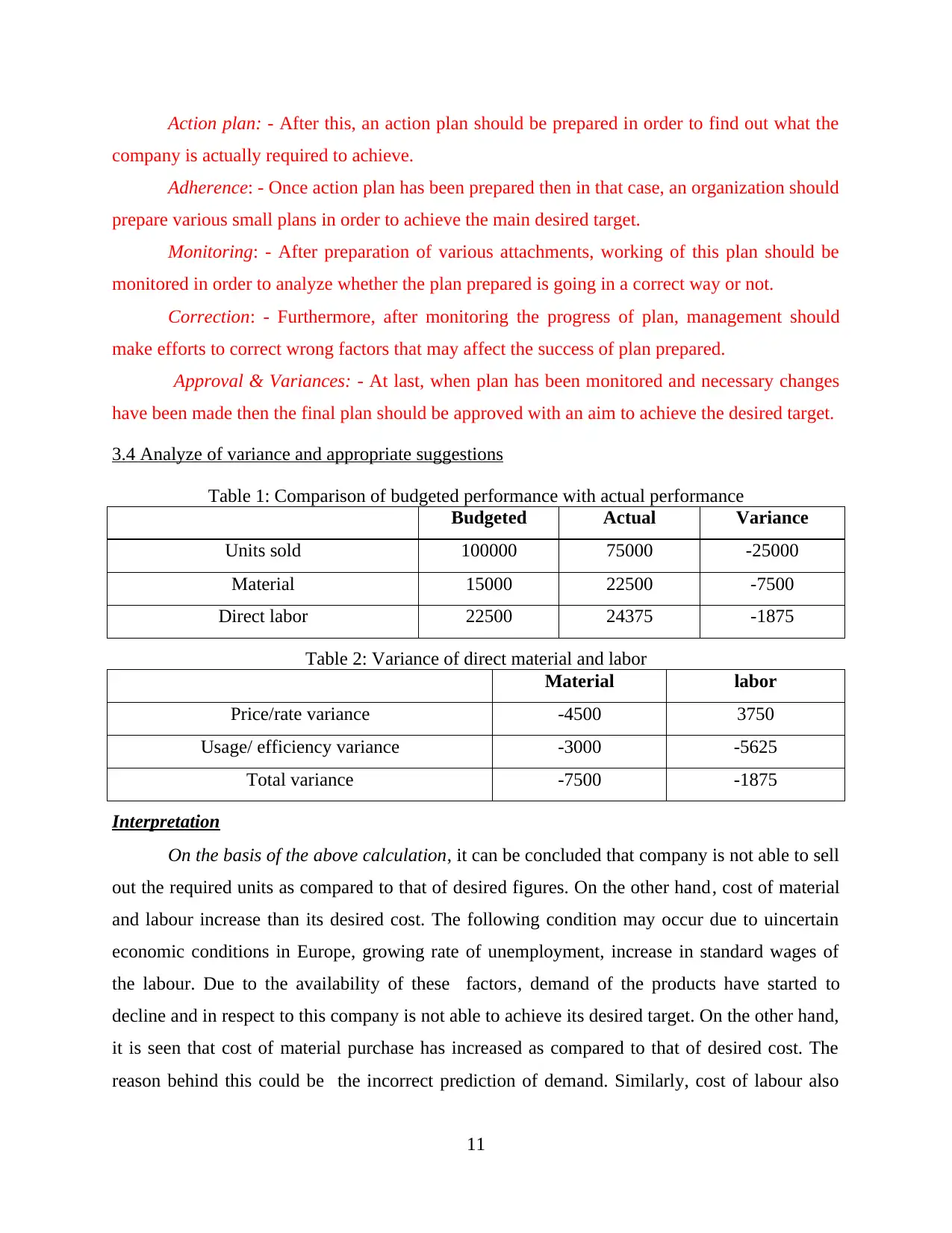
Action plan: - After this, an action plan should be prepared in order to find out what the
company is actually required to achieve.
Adherence: - Once action plan has been prepared then in that case, an organization should
prepare various small plans in order to achieve the main desired target.
Monitoring: - After preparation of various attachments, working of this plan should be
monitored in order to analyze whether the plan prepared is going in a correct way or not.
Correction: - Furthermore, after monitoring the progress of plan, management should
make efforts to correct wrong factors that may affect the success of plan prepared.
Approval & Variances: - At last, when plan has been monitored and necessary changes
have been made then the final plan should be approved with an aim to achieve the desired target.
3.4 Analyze of variance and appropriate suggestions
Table 1: Comparison of budgeted performance with actual performance
Budgeted Actual Variance
Units sold 100000 75000 -25000
Material 15000 22500 -7500
Direct labor 22500 24375 -1875
Table 2: Variance of direct material and labor
Material labor
Price/rate variance -4500 3750
Usage/ efficiency variance -3000 -5625
Total variance -7500 -1875
Interpretation
On the basis of the above calculation, it can be concluded that company is not able to sell
out the required units as compared to that of desired figures. On the other hand, cost of material
and labour increase than its desired cost. The following condition may occur due to uincertain
economic conditions in Europe, growing rate of unemployment, increase in standard wages of
the labour. Due to the availability of these factors, demand of the products have started to
decline and in respect to this company is not able to achieve its desired target. On the other hand,
it is seen that cost of material purchase has increased as compared to that of desired cost. The
reason behind this could be the incorrect prediction of demand. Similarly, cost of labour also
11
company is actually required to achieve.
Adherence: - Once action plan has been prepared then in that case, an organization should
prepare various small plans in order to achieve the main desired target.
Monitoring: - After preparation of various attachments, working of this plan should be
monitored in order to analyze whether the plan prepared is going in a correct way or not.
Correction: - Furthermore, after monitoring the progress of plan, management should
make efforts to correct wrong factors that may affect the success of plan prepared.
Approval & Variances: - At last, when plan has been monitored and necessary changes
have been made then the final plan should be approved with an aim to achieve the desired target.
3.4 Analyze of variance and appropriate suggestions
Table 1: Comparison of budgeted performance with actual performance
Budgeted Actual Variance
Units sold 100000 75000 -25000
Material 15000 22500 -7500
Direct labor 22500 24375 -1875
Table 2: Variance of direct material and labor
Material labor
Price/rate variance -4500 3750
Usage/ efficiency variance -3000 -5625
Total variance -7500 -1875
Interpretation
On the basis of the above calculation, it can be concluded that company is not able to sell
out the required units as compared to that of desired figures. On the other hand, cost of material
and labour increase than its desired cost. The following condition may occur due to uincertain
economic conditions in Europe, growing rate of unemployment, increase in standard wages of
the labour. Due to the availability of these factors, demand of the products have started to
decline and in respect to this company is not able to achieve its desired target. On the other hand,
it is seen that cost of material purchase has increased as compared to that of desired cost. The
reason behind this could be the incorrect prediction of demand. Similarly, cost of labour also
11
⊘ This is a preview!⊘
Do you want full access?
Subscribe today to unlock all pages.

Trusted by 1+ million students worldwide
1 out of 25
Related Documents
Your All-in-One AI-Powered Toolkit for Academic Success.
+13062052269
info@desklib.com
Available 24*7 on WhatsApp / Email
![[object Object]](/_next/static/media/star-bottom.7253800d.svg)
Unlock your academic potential
Copyright © 2020–2025 A2Z Services. All Rights Reserved. Developed and managed by ZUCOL.





